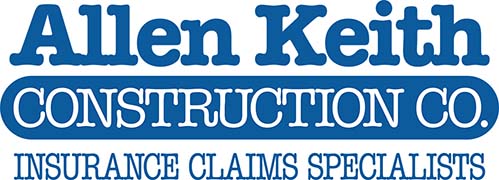Working with Insurance
After a disaster, you want to get back to normal as soon as possible, and so does your insurance company. Your insurer may issue you multiple checks as you make temporary repairs, permanent repairs and replace damaged belongings. Our project estimators have been trained by licensed insurance adjusters. This provides you an advantage, as our team has inside knowledge on how to navigate the entire claims process.
We suggest that an Allen Keith Construction project estimator inspect your property to confirm the extent of damage prior to filing an insurance claim.
The First Payment is Not Final
According to Insurance Information Institute, in most cases, an adjuster will inspect the damage to your home and offer you a specific amount of money for repairs based on the terms and limits of your homeowners insurance policy when working with insurance. The first check you receive from your insurance company is frequently an advance against the total settlement amount rather than the final payment. If you are offered an on-the-spot settlement, you may accept the check immediately.
If you discover additional damage later, you can reopen the claim and file for an additional amount. Most policies require claims to be filed within one year of the disaster date; check with your state insurance department for the laws that apply to you.
You Might Receive Several Checks Working With Insurance
When your home’s structure and personal belongings are both damaged, you will typically receive two separate checks from your insurance company—one for each category of damage. If your home is uninhabitable, you will also be compensated for the additional living expenses (ALE) you will incur if you are unable to live in it while it is being repaired. If you are working with insurance, have flood insurance and have experienced flood damage, you will receive a separate check for that as well.
Your Payment Might be Controlled by Your Lender or Management Company
If you have a mortgage on your home, the repair check is usually made out to you and the mortgage lender. Lenders normally ask that they be mentioned in the homeowners policy and a party to any insurance payments related to the structure before offering a mortgage. When working with insurance, your building’s financial organization may have been designated as a co-insured if you live in a co-op or condo so the lender can ensure the essential repairs are performed.
If a financial backer is co-insured, they must endorse the check before it may be cashed. Depending on the situation, lenders may deposit funds in an escrow account and pay for repairs when they are made. Show the mortgage lender the contractor’s bid and how much the contractor wants upfront. Your mortgage company may want to evaluate the work before paying the contractor.
If your home is destroyed, your insurance policy, its limits, and your mortgage dictate the amount and who gets it. For example, the insurance funds could be utilized to pay down the mortgage. You decide whether to rebuild on the same lot, in a different place, or not to rebuild at all. State legislation also drives these choices when working with insurance.
